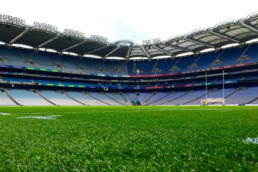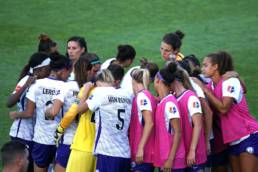While the challenges female athletes face in comparison to male athletes can be similar, for the most part they are very different. Through our international project HerForm, we spoke with German basketball player Lisa Koop about the specific barriers she faced during her long career and the importance of gender-specific support in addressing the systemic disparities between women and men in high-level sports.
Adolescence marks the transition from childhood into adulthood. This phase is characterized by cognitive, psychosocial, and emotional developments (Arrington-Sanders, 2013) that show substantial differences between genders. Linked, one aspect that is often overlooked in sports is the fact that support requirements differ substantially across athlete sub-groups.
Support requirements: same same, but (very) different
While all athletes face their own set of hurdles, the path to success for women in sports is often marked by unique challenges that differ significantly from those of men. Individually, these challenges are connected to topics such as identity, self-care, mental health, communication, or vocational development. Institutionally, these challenges are interrelated with the (non-)existence and nature of systematic pathway programmes, as well as to the type of semi-professional to professional senior level structures. A longer history, commercial interests, and, linked, media coverage are main reasons for men’s team sports being substantially larger-scaled and more resourceful than the women’s side.

At the same time, this infrastructural gap between women and men slowly lessens. Many female team sports are on an unprecedented rise. The UEFA European Women’s Championship 2025, along with three compelling examples that follow, serves as powerful proof of this progress.
- “Women’s rugby is now one of the fastest growing team sports in the world. In total, more than 2.7 million women and girls play in professional leagues, at the Olympics, at universities and even in grade school.” (Mastercard Newsroom, 2021).
- The European Championships 2018 in women’s handball were shown in 135 countries by 65 broadcasters, with a total of 2,749 hours of coverage, a growth of almost 40% on the previous tournament in 2016 (European Handball Federation, 2019).
- Based on TV deals enhancing accessibility, the increase of people in the EU watching women’s football is estimated to be 358.7% (The Guardian, 2021).
With this growth in players, event sizes and publicity comes growth in terms of female athlete demands and challenges. Upgrading education for and through female athletes must therefore be given increased attention.
State of play
Male high-performance sport commonly features a clear pathway from youth to senior level, which has supported the development of specialized personal development programmes for male athletes. In contrast, similar pathways for female high-performance sport are often less established across Europe. This gap means that development programmes for women’s sports are either non-existent or are simply adapted from male-centric models, resulting in an unspecific and often inadequate approach.
The need for additional support for female high-performance athletes is well supported by international research and initiatives. However, policies and initiatives mainly focus on female participation and promotion of female athletes while systematic research and programmatic practice on female-specific issues within high-performance sport is scarce. Further work is required that targets female high-performance athletes allowing their voice to lead the development of a learning programme bespoke for their needs.
The right support
What is required is not just some educational support in women’s sport, but the right support: gender-specific, multi-disciplinary, and evidence-based. Support service providers are asked to equip themselves with knowledge, tools and techniques that can be directly applied to their work with female high-performance athletes.
This is exactly what the international project HerForm, co-designed by TWIN, strives for. By creating a personal development online training course for female athletes, the project seeks to address the challenges female athletes face; with a strong focus on their first-time transition into high-performance environments. By understanding the personal skills needed for high-performance sport, amplifying athlete voices, and building tailored support systems, HerForm is laying the foundation for a brighter future.
A conversation with Lisa Koop
One example of a female athlete in team sports is Lisa Koop, a veteran of the German women’s national basketball team. Her journey started in Marburg, Germany, where she first discovered her passion for basketball. Growing up near a gym and having access to both first and second division teams at a young age allowed her to develop her skills early on, setting the foundation for a remarkable career.

Today, she stands as a legend of the German women’s national basketball team, representing her country on the international stage. Alongside her athletic achievements, Lisa has also balanced the demanding worlds of professional sports and academics, successfully completing master degrees in Psychology (University of Giessen), and Sport and Exercise Psychology (Northumbria University).
However, as impressive as her story sounds, it has not been without its share of struggles and setbacks. Like many female athletes, Lisa has faced significant barriers throughout her career. Limited resources and support, unfair compensation and lack of visibility have made her progress slow and difficult.
“It’s not even so much about equal pay but more importantly about equal play – access to facilities, more respect, good medical care. Honestly, it’s infuriating that things still aren’t better today.”
Lisa Koop
Professional basketball player
HerForm recently sat down with Lisa to hear about her personal experiences. Here are some of the most insightful moments from our conversation.
HerForm launch event in November
Save the date: November 13, 2025, Dublin, Ireland. The HerForm Conference will introduce the personal development online training course for female athletes, and targets athletes, practitioners in high-level sport, education and training professionals, as well as political decision-makers.
More information on the event will be announced soon.
•
•
•
References
- Sanders-Arrington, R. (2013): Adolescent psychosocial, social, and cognitive development. Pediatrics in review, 34(8), 354-359
- Mastercard Newsroom (2021): Women’s rugby is surging. Its next chapter will be even bigger. URL: https://www.mastercard.com/news/perspectives/2021/womens-rugby-sponsorship/. dwl: 11 August 2025
- European Handball Federation (2019): Women’s EHF EURO 2018 scores TV and digital success. URL: https://www.eurohandball.com/en/news/en/women-s-ehf-euro-2018-scores-tv-and-digital-success/. dwl: 10 August 2025
- The Guardian (2021): Women’s football set for huge increase in viewing figures globally. URL: https://www.theguardian.com/football/2021/apr/21/womens-football-increase-viewing-figures-globally/. dwl: 11 August 2025




